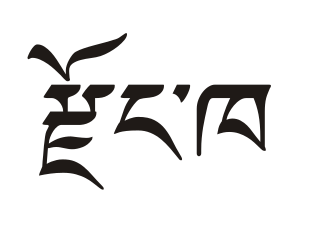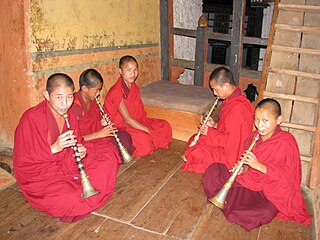History
In 1989, Ugyen India directed Gasa Lamai Singye, the first, pioneer Bhutanese feature film. [8] Gasa Lamai Singye, a tragic love story reminiscent of Romeo and Juliet , had a remake in 2016, directed by Sonam Lhendup Tshering. [9] Wangdi went on to direct several documentary films [10] His Yonten Gi Kawa (Price of Knowledge, 1998) was the first documentary made in Bhutan, and followed the daily life of a 11-year-old boy at home and school. It was followed by Yi Khel Gi Kawa (Price of A Letter, 2004), where Wangdi tells the story of a postal runner who worked throughout Bhutan for 26 years. [8]
In 1999, Tshering Wangyel released the first commercially successful movie in Dzongkha language, Rewaa (Hope), a love story where two college boys fall for the same girl. As one critic put it, "the commercial Bhutanese film industry was born." [4] Wangyel went on to produce some 50 movies and died of pneumonia while making his last film. [11] [12] In 2007, he had produced Bakchha , the first Bhutanese horror movie.
Buddhist lama Khyentse Norbu wrote and directed four award-winning films, The Cup (1999), Travellers & Magicians (2003), Vara: A Blessing (2013), and Hema Hema: Sing Me A Song While I Wait (2016). [4] Travellers & Magicians was the first feature film to be entirely shot within Bhutan. Hema Hema, which tells its story by following a mysterious ritual in the forest where all participants are masked, was praised by critics for "its portrayal of complex Buddhist themes like transgression, by juxtaposing them on to modern topics like anonymity on the Internet." [4] Another Buddhist lama, Neten Chokling, appeared in Travellers & Magicians, and in 2006 directed his own feature film, Milarepa .
The Holder, a short film, coordinated by Jamyang Dorji, debuted at the 2011 Cannes Film Festival and was screened in Brussels together with Original Photocopy of Happiness by Dechen Roder, [13] a young director from Bumthang who went on to direct in 2016 the mystery film Honeygiver Among the Dogs . The movie was described as "a genre-bending work, blending elements of neo-noir with Bhutanese mysticism." [4]
in 2014, Karma Dhendup directed Ap Bokto , a 3-d computer-animated fim based on a Bhutanese folk tale. In 2016, Drukten: The Dragon's Treasure was the first Bhutanese 2-d animation movie. [8]
For contemporary content, in 2017, R.C. Chand's film Thimphu was hailed as "doing away with the notion that all independent Bhutanese movies draw upon the country's Buddhist mysticism." It presents the life of Bhutan's capital through different characters, including an alcoholic family, a transgender woman, and a young singer with problems of career and love. [4]
Female directors are rare in Bhutan. One is Kesang Chuki, who produced ten documentaries, docudramas, and short movies, including Nangi Aums to Go-thrips (Housewives to Leaders, 2011), about the problems of Bhutanese women who assume public roles, and A Young Democracy (2008), where Chuki accompanies two candidates in their campaigns for the first ever democratic election in Bhutan. [10]
The Next Guardian was the first feature-length documentary film by Bhutanese director Arun Bhattarai and Hungarian director Dorrotya Zurbo. It premiered at IDFA, 2017 and was featured in MoMA among several other film festivals.
The Bhutan Beskop film celebration (2010, 2011) was a significant event for the local film industry. Financial specialists and sometimes banks fund new productions that are screened in one of Bhutan's several cinemas, of which the Lugar Lobby in Thimphu with 880 seats is the biggest. [14]
A sum of 152 Bhutanese movies were created in the main decade of the 21st century. Bhutan has two distribution houses. Business movies are periodically in light of an "affection" subject, here and there joined with a social issue (HIV, urbanization) taking after a customary script with exchanges, tunes, dances, complicated relations and a battle. Spending plans change from $15,000 to $50,000. Compensations for performers and vocalists have gone up from $1,000 (2006) to $10,000 per film for top on-screen characters in 2011. Real uses for film preparations are coordinations, gear and compensations. The gross income for a well known film (up to 90,000 onlookers) may reach up to $140,000, while less well known movies may raise half of it and unpopular movies hazard shortages. [15]











